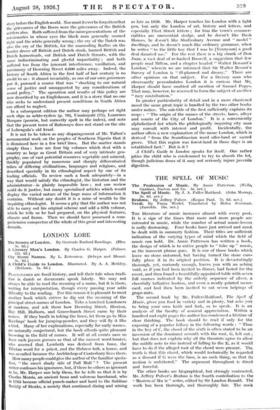LONDON LORE .
The Streets of London. By Gertrude Burford Rawlings. (Bles. 3s. 6d.)
A Literary Man's London. By Charles G. Harper. (Palmer. 12s. 6d.)
A Child's Guide to London. Illustrated. By A. A. Methley. (Methuen. is. 6d.)
PLACE-NAMES are fossil history, and tell their tale when tradi- tion is dumb or documents speak falsely. We may not always be able to read the meaning of a name, but it is there, waiting for interpretation, though every passing year adds difficulty to the reading. For this reason it is pleasant to meet another book which strives to dig out the meaning of the principal street-names of London. Take a hundred Londoners at random, and ask them how Downing Street, Hoxton, Hay Hill, Holborn, and Gracechurch Street came by their names. If they baulk in taking the fence, let them go to Miss Rawlings' book for jumping-powder, and they will fly it like a bird. Many of her explanations, especially for early names, are naturally conjectural, but the book affords quite pleasant browsing in the field of names. It will at all events save us from such joyous guesses as that of the earnest word-hunter, who averred that Lambeth was derived from lama, the Tibetan word for a priest, and the Hebrew beth, a house, and was so called because the Archbishop of Canterbury lives there.
How many people could give the author of the familiar quota- tion, " the sweet shady side of Pall Mall " ? The present
writer confesses his ignorance, but, if there be others as ignorant as he, Mr. Harper can help them, for he tells us that it is by Charles Morris, an ancient beau and valorous bacchanal, who In 1785 became official punch-maker and bard to the Sublime Society of Steaks, a society that continued dining and wining
as late as 1850. Mr. Harper touches his London with a light pen, but only the London of art, history and letters, and especially Fleet Street letters ; for him the town's commer- cialities are unessential stodge, and he doesn't like Bush Houses, he doesn't like Shaftesbury Avenue and " model " dwellings, and he doesn't much like ordinary grammar, when he writes " to the little boy that I was he [Tennyson] a good deal daunted me." For the rest there is a big chunk of Don Juan, a vast deal of re-hashed Boswell, a suggestion that few people read Milton, and a chapter headed " Walter Beasant's London," wherein we are informed that Sir Walter Besant's Survey of London is " ill-planned and dreary." There are other opinions on that subject. For a literary man who observantly perambulates London it is curious that Mr„ Harper should have omitted all mention of Samuel Pepys. That may, however, be reserved to form the subject of another " racy contribution."
In greater particularity of detail and in a more chastened mood the same great topic is handled by the two other hooks under notice. The sub-title of the first sufficiently explains its scope : " The origin of the names of the streets, lanes, alleys and courts of the City of London." It is a conveniently alphabetized list which the philologically inquiring city man may consult with interest and profit. Incidentally, the author offers a new explanation of the name London, which is derived " from the Scandinavian word offer-lund or sacred grove. That this region was forest-land in those days is an established fact." But is it ?
A Child's Guide to London speaks for itself. One rather pities the child who is condemned to try to absorb the lot, though judicious doses of it may not seriously injure juvenile digestion.






































 Previous page
Previous page